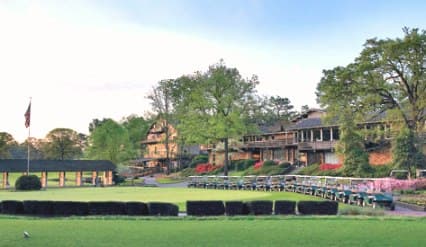Pine Needles Resort & Golf Club

Pine Needles Resort & Golf Club, is a Resort, 18 hole golf course located in Southern Pines, North Carolina.
Pine Needles Golf Course first opened for play in 1927. The course was designed by Donald Ross. The course was restored in 2004 by John Fought.
Pine Needles Golf Course plays to a par-71 and a maximum distance of 7,015 yards. The course rating is 72.2 with a slope rating of 131.
Pine Needles is consistently ranked as one of the Top 100 Courses You Can Play by Golf Magazine's panel of experts. Tucked in amid magnolias, hollies, dogwoods, and longleaf pines--and throw in some brilliant azaleas in springtime--Pine Needles is pure delight, yet a strong enough test to have hosted the U.S. Women's Open in 1996, 2001, and 2007. Pine Needles is a classic memorable golf course. You need every club in your bag and you remember every hole after you play it one time. The holes feel like they've been there forever.
The course was laid out by famed Scottish-born architect Donald Ross. Golf architect John Fought of Scottsdale has restored the course to its original glory."We want to remind people that this is a Donald Ross golf course, and it will remain a Donald Ross golf course," Fought says. "We're getting back to Ross in every way we can. Some elements had been lost, and we've had to step back in time to rediscover some of the things he did." Following the restoration, the Pine Needles course measures more than 7,000 yards in length because some holes have been stretched to return the shot values that Donald Ross intended.
For example, fairway bunkers are now placed so that they serve as the kind of hazard that Ross intended from the tees. The short par-5s that had begun to feel like par-4s for those using modern equipment feel like par-5s again. Whatever the changes, you'll be playing your round on a rolling landscape dotted with maples, holly trees, azaleas, dogwood, blackjack oaks, and loblolly pines. Although the course is always meticulously groomed, it remains naturally scattered with gentle sandy hills and hollows. You're going to find wide fairways with multi-directional slopes.
# 3 is one of the signature holes, a short par-3, you need to make a precise tee shot over a small pond and wetlands area. The putting surface slopes sharply from back to front, making three putts a possibility. If the pin is placed directly over the front bunker and short of the back bunker, your shot will be tough to place.
#4 is par-4 with a pine tree-lined fairway requiring an accurate drive. Picking a club is tough as you make your uphill approach to the green because the hole plays longer than it looks. The right front bunker is deceptive because it might make you think it's right beside the putting surface when it's 20 yards in front.
#10 is a dogleg left par-5 with a dramatic bunker hugging the inside of the corner of the turn. A well-struck tee shot, however, can clear the bunker and leave a long iron or fairway wood to the green.
As part of the effort to restore the course to its original layout, # 14 and # 15 have been reverted to their original pars as designed by Ross. #14 has become a par-4 again, and # 15 a par-5. New tee boxes have been built to provide for the change.
#18 is a par-4 that requires a downhill approach shot to a green that's difficult to hold.